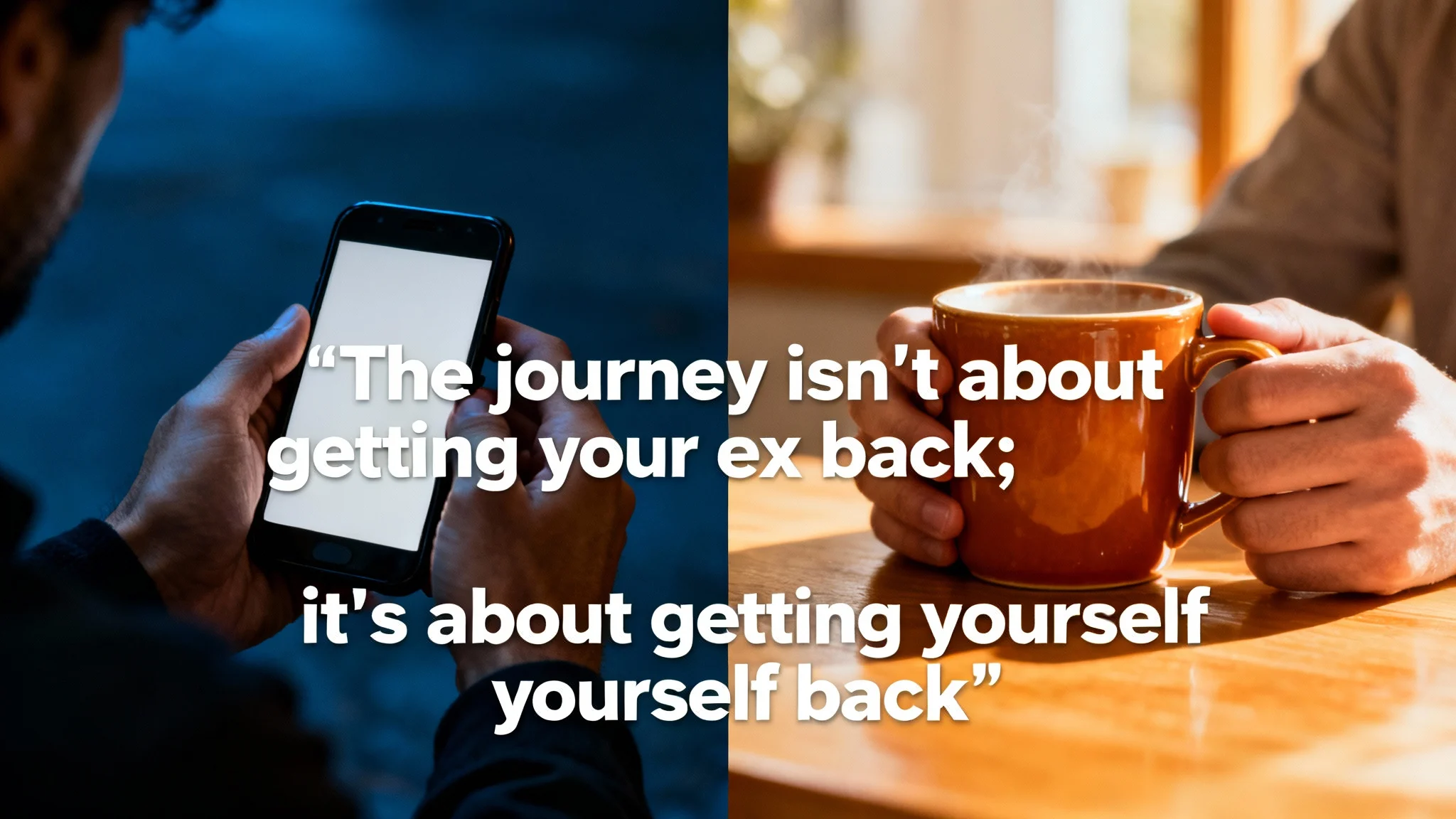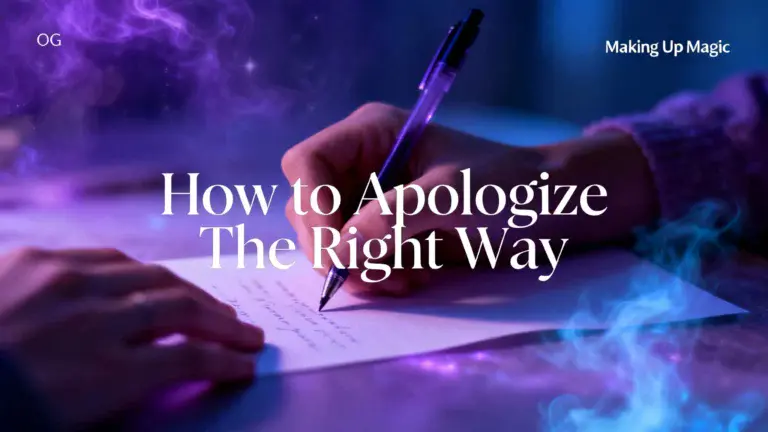If you’re here, your heart is loud and your head is tired. Breathe. You are not crazy, you are in pain—and pain wants relief now. Here is the shortest, clearest help I can give you, then we’ll go deeper.
On This Page:
Quick Answers for the 3 Most Searched Moments
I want my ex back — what do I do first?
Answer: Stop chasing for 72 hours, stabilize your nervous system, and choose a plan. For most, that plan begins with No Contact (21–30 days) while you fix the root issues and rebuild attraction. Then re‑open gently with the right first text (here), watch for return signals, and avoid the big mistakes.
I want my ex back so bad — how do I stop the urge to text?
Answer: Use the 10‑minute “urge surf”: set a timer, breathe in for 4, out for 6, and write what you would text but don’t send it. Pray “God, trade my panic for Your peace.” Then move your body for 10 minutes. Repeat 3 times. If the urge remains, schedule a time tomorrow to review (not act) and return to No Contact.
I want my ex back but they’ve moved on — is there any hope?
Answer: Yes, but only through integrity. If they’re with someone else, do not interfere. Commit to a longer season of No Contact, heal, and rebuild your life. Later, a single, clean outreach is acceptable if you honestly believe a healthy relationship is possible. If not, you release them, and God will not waste your pain.
Fast Relief Tools
The Two Paths: Choosing Your Response with Wisdom
How you respond in this moment will define your entire journey. You have two choices: the path of panic, which leads to more pain, or the path of grace, which leads to healing and strength. I’ve seen it time and time again, and it reminds me of these simple truths.
The Gardener and the Walled Garden
Imagine your relationship was a shared garden. The breakup has built a high wall right down the middle. The Path of Panic is to immediately start trying to climb that wall, which only makes them build it higher. The Path of Grace is to accept the wall for now. You turn and tend to your own soil—pulling weeds of resentment and planting seeds of new hobbies and faith. Soon, your side of the garden is so beautiful that they might just become curious about the person who could create such a paradise on their own.
The Thirsty Traveler in the Desert
The intense pain of a breakup is like being a traveler lost in a desert, dying of thirst. Your ex appears like a shimmering oasis. The Path of Panic is to sprint towards that mirage, leaving you more exhausted and lost than before. The Path of Grace is to stop and find a real source of water—a trusted friend, prayer, a moment of self-care. Once you are no longer dying of thirst, you can see clearly, and you have the strength to walk towards a real river, with or without them.
The Captain and the Second Ship
You and your ex were captains of two ships. Their ship has turned and sailed away with a new co-captain. The Path of Panic is to give chase in your damaged vessel, causing your own ship to sink. The Path of Grace is to guide your vessel into a quiet harbor to make repairs. You mend your confidence and chart a new map for yourself. You become the sole, confident captain of your own journey, ready for any ocean—and any destination.
The Compassionate Plan: Stabilize → Heal → Reconnect (If Wise)
When you say “I want my ex back,” you’re also saying, “I want my peace back.” The right plan gives you both. Here’s the path that preserves your dignity and keeps the door open if reconciliation is truly right.
Step 1 — Stabilize (First 72 Hours)
- Stop all chasing. No calls, long texts, ultimatums, or “closure” speeches.
- Regulate your body: sleep window, hydration, 20 minutes of movement. You can’t outthink a flooded nervous system.
- Journal the breakup story from both sides: “What they’d say I did wrong.” It hurts. It also heals.
- Prayer: “Lord, let truth be my compass and love be my method.”
Step 2 — No Contact (21–30 Days, Longer if They’ve Moved On)
No Contact isn’t a trick; it’s a reset. It protects your dignity, lowers anxiety, and lets attraction breathe again. Learn how it actually works here: Does No Contact Work?
- If your ex is single: 21–30 days is typical.
- If your ex is dating someone: extend; do not triangulate. You’re choosing integrity over tactics.
- Track return signals (curiosity, soft likes, mutual friends asking about you).
Step 3 — Heal What Broke (Your Personal Upgrade)
Attraction returns when the root issues change. Ask: “What patterns must end so we don’t repeat the past?”
- Attachment check: anxious? avoidant? Both can be healed.
- Cycle‑breaker moves: therapy, male/female mentorship, sleep/exercise basics, social re‑entry, and one life‑giving habit you can keep.
- Spiritual alignment: forgiveness prayer by name; sow peace, reap clarity.
Step 4 — Reopen Gently (Only If It’s Truly Wise)
When you are calm, clear, and ready, use a light, low‑pressure text. Get full scripts here: What to Text Your Ex After No Contact. Then graduate to these: Best First Texts.
- Green‑light cues: they engage naturally, ask questions, share positive nostalgia, suggest meet‑ups.
- Yellow lights: breadcrumbing, hot/cold, triangle talk.
- Red lights: disrespect, secrecy, “we can hook up but I’m not ready.” Protect your soul.
“So Bad” Protocol: When Craving Hits Like a Wave
If you feel like, “I want them back so bad it hurts,” you’re normal. Withdrawal is real. Here’s the protocol:
- 10‑minute urge surf (breathe 4‑in/6‑out + write but don’t send).
- Move your body for 10 minutes; change state.
- Script swap: replace “I can’t live without them” with “I’m learning to breathe without them.”
- Re‑read your “both sides” breakup journal. Find the lesson you will not repeat.
- Anchor a win (one hard, tiny task). Confidence compounds.
If They’ve Moved On: Your Ethical Path
God is not honored by manipulation. Here’s the way of integrity:
- Zero interference. Do not “be their friend” to undermine their relationship.
- Extend No Contact and rebuild your life. If they circle back, you’ll be ready or already past it.
- One clean message (optional, later): “I respect your life and won’t intrude. If you’re ever genuinely open to exploring a healthy future, you know where to find me. Wishing you well.” Then release.
Common Mistakes That Ruin Second Chances
- Over‑contacting and push/pull games
- Using jealousy to provoke them
- Skipping the healing work and repeating old patterns
- Confusing loneliness with love
FAQs
1. I want my ex back, what should I do first?
The very first thing you need to do is stop everything. Don’t text, don’t call, don’t post anything online aimed at them. Your first move is to take a deep breath and commit to a period of true No Contact. This isn’t a trick to make them miss you; it’s a lifeline to help you find your own footing again. The first step back to them is actually a step back to yourself.
2. I want my ex back so bad it hurts. How do I stop the pain?
I know that pain. You can’t “stop” it, but you can learn to carry it. Treat your emotional pain like a physical injury: 1) Talk to someone you trust. 2) Move your body, even for just 10 minutes. 3) Write it all down on paper that no one else will see. The intensity will fade, I promise. Your job isn’t to fight the wave of pain, but to learn how to stay afloat until it passes.
3. I want to get back with my ex, but I don’t know if they want me back.
It’s normal to feel this uncertainty. Trying to guess what they’re thinking will drive you crazy. Shift your focus from “Do they want me?” to “Am I becoming the best version of myself?” The first question leads to anxiety; the second leads to strength. If you find yourself constantly looking for clues, it might be helpful to understand the common signs and signals your ex might be sending, but don’t let it become an obsession.








Hey Robert,
Thoughtful take on a tender topic. From my own experience, the most productive first step wasn’t a grand gesture—it was a quiet reset: no-contact for a bit, therapy or journaling to see my part clearly, then a calm check-in only if I could accept either outcome. Two questions to deepen the convo: how do you help people decide whether they truly want reconciliation or just relief from pain? And if both parties are open to talking, do you recommend a structure for that first conversation (time limit, topics, boundaries) so it doesn’t spiral out of control?
Marios
Hey Marios,
Thank you for this incredibly thoughtful comment. You’ve hit on the absolute heart of the matter, and your wisdom about being able to “accept either outcome” is the foundation of true healing and strength. I appreciate you sharing that.
You’ve asked two profound questions that get to the core of a healthy, faith-led approach. Let me do my best to answer them.
1. How do you decide between wanting true reconciliation and just wanting relief from pain?
This is the most important discernment a person can make. Relief is a feeling, but reconciliation is a covenant. One is about soothing the self, the other is about building a future.
Here’s the test I guide people through, a “stillness test” to find the truth:
The Nostalgia Test: Are you replaying a highlight reel of the good times? Or are you looking at the whole picture—the patterns, the hard days, the root issues—and believe you both have the tools to fix what was broken? Relief lives in nostalgia; reconciliation lives in reality.
The “Empty Chair” Test: Sit quietly and imagine your life, peaceful and whole, six months from now. Now, imagine your ex walks in and sits in the empty chair beside you. Does their presence add to your peace, or does it feel like a desperate attempt to fill it? Relief seeks a filler; reconciliation seeks a partner.
The God Test (The Ultimate Litmus): In prayer, ask this: “Lord, is my desire for them pulling me closer to You, or is it a distraction from the healing You’re trying to do in me?” God’s will is never for us to use another person to avoid our own growth. Relief is often an idol; true reconciliation is a partnership that honors Him.
If you’re still wrestling with this, the best tool I can recommend is taking the 60-second Breakup Clarity Quiz. It’s designed to help you uncover your true motivation.
2. What’s a structure for that first conversation so it doesn’t spiral?
You’re right, that first meeting is fragile. The key is to build a “safe container” for the conversation with clear boundaries. The goal is not to solve everything; it’s simply to re-establish a positive, respectful connection.
Here is the structure I recommend:
The Time Limit: Keep it to 60 minutes. A coffee, not a dinner. This lowers the pressure immensely and gives both people an easy, pre-planned exit.
The Territory: Meet on neutral ground. A quiet coffee shop or a park. Avoid your old haunts or either of your homes, which are full of emotional triggers.
The Topic: The stated purpose should be simple: “To catch up.” This isn’t the time to re-litigate the breakup. Avoid blame and focus on “I” statements about what you’ve learned about yourself. If you need a script for that initial outreach, our guide on the first text after no contact can help set the right tone.
The Boundaries (The Non-Negotiables):
No Blame: This is the #1 rule and one of the biggest mistakes people make.
No Alcohol: Stay clear-headed.
No Future-Tripping: Avoid making promises or plans for the future. Stay in the present moment.
Have an Exit Phrase: Agree that if things get tense, either of you can say, “This has been good, but I think this is a good place to stop for today.” It’s an emergency brake that preserves dignity.
Marios, your questions are the kind that lead to real healing, whether that means reconciliation or a healthy new beginning. Thank you again for adding so much value to this conversation.
Blessings,